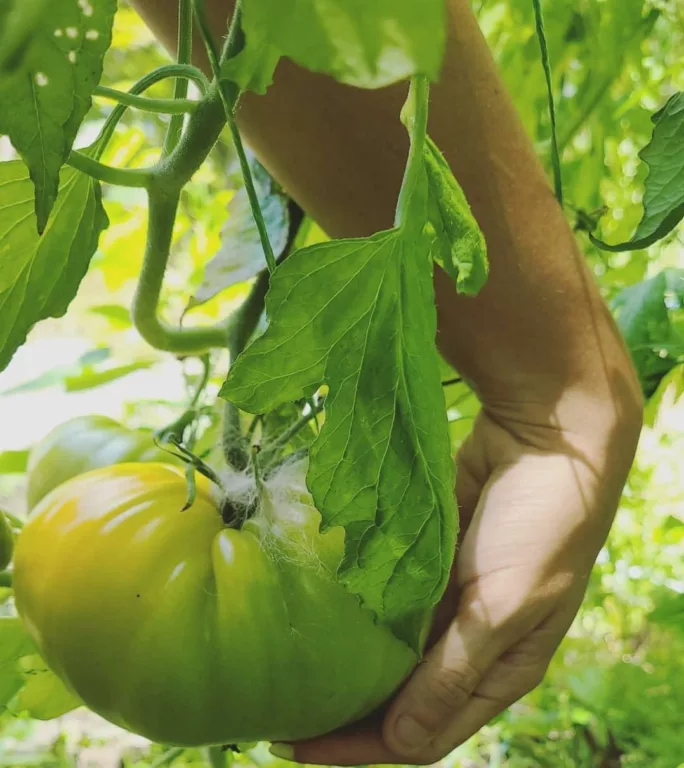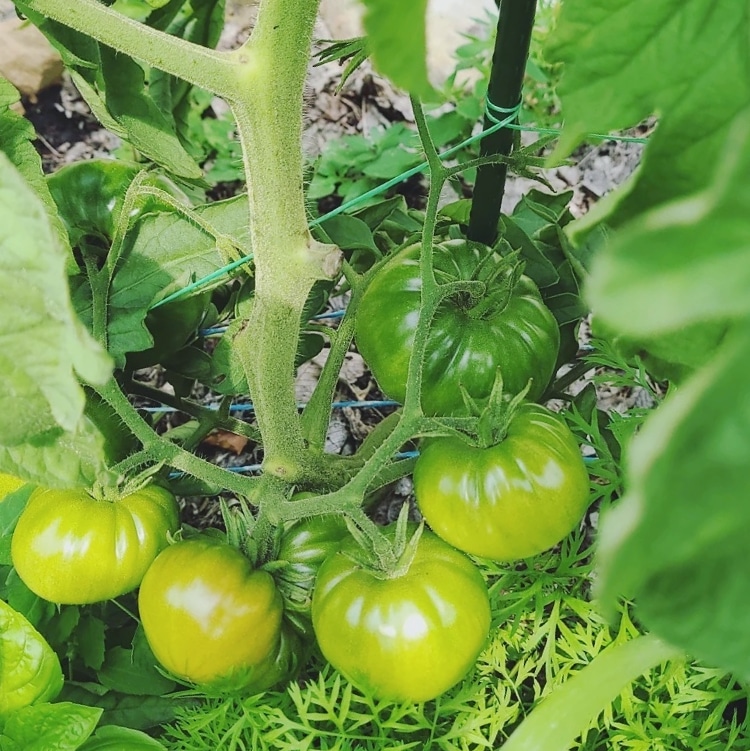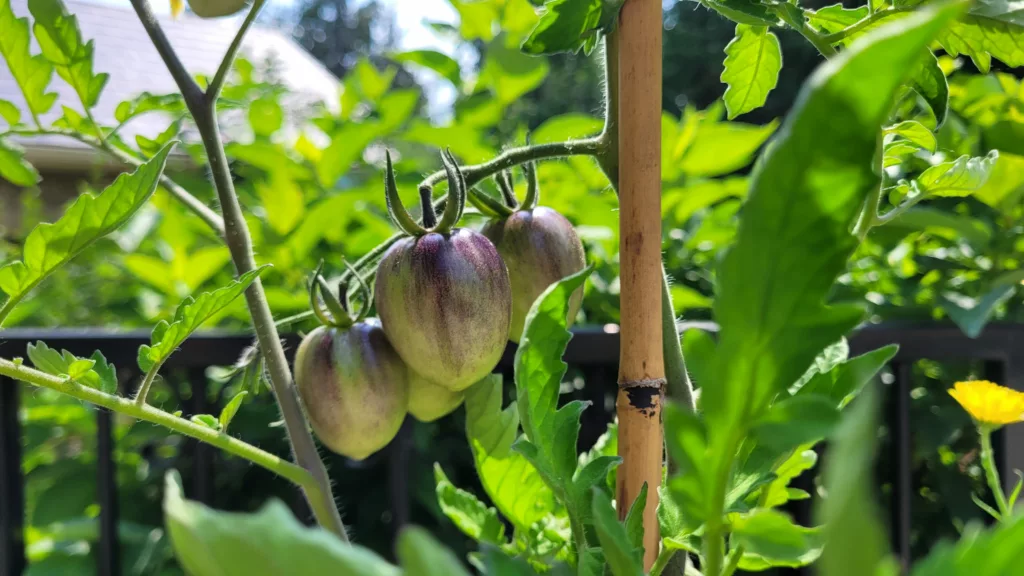This post may contain affiliate links. If you use these links to buy something we may earn a commission. Thanks.
If clay is all you got, and fresh tomatoes are a must-have then you’ll need to know a few things about growing tomatoes in poor soil, otherwise known as heavy clay.
In the beginning, we wondered if tomatoes could even grow in clay; it’s all we had. After experimenting with a few methods, we learned all we needed to know about growing tomatoes in clay soils.
Tomatoes will grow in clay soil if it’s loosened, amended, and mulched with organic matter. Clay is a nutrient-rich type of soil, but it’s crucial to introduce air space and add organic matter to keep it softened and prevent compaction.
Nutrients are a thriving tomato’s best friend! So the key with clay is to make everything accessible. First, you should understand the problems, then you’ll learn what to do about them.
Clay is a challenge for tomatoes when it’s compacted and heavy, and therefore, alkaline:
- While tomatoes love water, wet clay is very heavy and ‘impossible’ to puncture. Soft tomato roots have a tough time breaking through compacted walls that don’t offer any space to explore.
- The ideal soil pH for tomatoes is slightly acidic between 6.2 and 6.8 (according to the University of New Hampshire) and clay tends to be alkaline(above 7 pH).
Tomatoes, like other plants, have a pH preference because it directly affects nutrient accessibility.
Michigan State University offered a straightforward explanation as to why clay soils aren’t typically acidic. Minerals such as calcium, magnesium, and potassium affect the pH with their presence. Since water has a tough time penetrating and passing through clay, fewer minerals and nutrients are leached away. Clay tends to retain water, and therefore has more nutrients and minerals.
These characteristics can be fixed by loosening and amending the soil.
See: 5 Phases to Create Well-Drained Clay Soil
How to Grow Tomatoes in Poor Soil, this year?

The key to growing tomatoes in clay successfully is to ultimately improve the conditions. You can approach this in several ways.
A short-term improvement plan will allow you to grow your tomatoes immediately. So what can you do to grow tomatoes in clay without having to wait a whole season or two?
To plant your tomatoes right away, the best steps are to aerate your clay, apply a 3-inch layer of compost, water, transplant your tomatoes, and mulch the surface. Each of these steps, in the order provided, is critical for a successful short-term crop.
A broad fork will be your new best friend for creating growable ground. Air pockets in the soil will allow water in and roots to find new places to stay.
Broad forks aerate clay at an appropriate depth for growing vegetables and are a less invasive version of tillage. Tillage is an essential first step to improving clay soils, but shouldn’t be continued forever if your goal is to build healthy soil.
- While heavy, broad forks are easy to use. Stand on it, pull it back to lift the surface a bit, wiggle it out, and repeat with 6-inch spacing.
- When finished broad forking your tomato bed, lay out a thin layer of compost, and gently water.
- After the water has been absorbed, plant your tomatoes.
- Finally, mulch the surface with leaves or straw. Mulching the surface is an essential step in growing tomatoes in clay.
If you don’t mulch the surface, even thinly, the clay will be compacted after the next few rains and your progress will come to a halt.
During this first year, after 2 months, use a liquid fish emulsion fertilizer every other week to ensure your tomatoes receive essential nourishment.
Aside from working your clay soil, the other option is to install and fill raised beds. This requires importing new soil and doesn’t really ‘fix’ your clay. It also doesn’t involve growing your tomatoes in the clay. But your clay will improve over time underneath your raised beds.
A broad fork is cheaper than installing raised beds, and over time, inground soil will require less upkeep than a raised bed.
Related: Ideal Crops for Clay Soil (Vegetables & Edible Perennials)
How to improve clay soil to grow better tomatoes?

To turn clay into the best tomato-growing soil, a long-term approach pays off. With a few extra steps, you’ll reap even better yields than you thought possible (and with less upkeep).
To grow tomatoes in clay long term, submit samples for a soil test, build swales on contour, loosen the clay, grow cover crops, and keep the soil covered at all times. In 3-5 years, you’ll have fluffy, humus-rich soil to grow any vegetable.
These extra steps go beyond your tomato bed and address a bigger picture. If you have the space and desire to turn your whole yard into rich soil where everything grows, these are the steps you need.
If you’re unable to do all of these, do as many as you can!
Submit samples for a soil test
A soil test is optional.
You’ll receive plenty of insights into what your soil has and needs.
Tomatoes prefer a pH between 6.0 to 6.8. If it’s too alkaline, you’ll know that you likely have plenty of minerals, and not enough air space.
Tomatoes also need access to:
- Nitrogen for vegetative growth
- Phosphorus for strong roots, flowers, and fruit
- Potassium for fruit development and disease resistance
- Calcium to prevent the dreaded blossom end rot and other diseases
- Magnesium for optimal photosynthesis
- Sulfur for structure and general health
- Boron, Manganese, Copper, Molybdenum, Iron, Zinc, and more micronutrients for various purposes
Your clay soil likely has plenty of these nutrients, but are they available to your tomatoes? The pH will be a big indicator.
At the minimum, a pH test would be ideal. Digital soil pH meters often cost less than a single pH test from a laboratory and you can use them again, and again.
Build swales on contour
If you plan on growing more than just tomatoes, swales are something you should at least know about.
Swales are a tree-planting system that results in a dought-resilient landscape that can mulch itself. This means less work for you!
See: Prepare the Ground for a Food Forest Properly (Full Guide)
To improve soil conditions for growing vegetables while decreasing your long-term workload, swales will help get much of the work done for you.
- Tree roots aerate the soil deeply, saving your back from broad forking forever.
- Tree leaves fall and keeps your garden beds mulched for the winter (rake leaves from paths and onto beds, this minimizes your need to transport or buy mulch from outside your yard)
- The shape of the swale catches water, allowing you to spend less money and time on watering gardens.
Basically, swales are a more passive approach to addressing the issues of clay on a long-term basis.
Loosen the clay
Loosening the clay can be done in several ways, but whichever way you choose, you need to target at least the top 8-12 inches of soil.
Some methods are easier than others at achieving this depth.
Tilling: Tilling should be done once or twice on clay soil at a minimum of 8 inches deep. It isn’t worth getting an electric tiller for long-term clay soil care as it can lead to worse compaction over time. Manual tilling can be done with a spade or pitchfork. Sometimes, clay is too thick and heavy for loosening with these tools. That’s where a broad fork is necessary. The tines are strong enough to leverage clay and spaced for penetrating with your full weight while less invasive and damaging than rototillers.
Double digging: If you’re able to dig your clay, and you have the strength and energy, you can (and should) get deeper by ‘double digging.’ To do so, dig a trench and set the soil aside, loosen the bottom of the trench with a pitchfork, and backfill the trench with the loose ‘side’ soil.
Grow cover crops and companion plants

Cover crops are a great way to loosen clay without disturbance.
If you can give your garden some time before planting tomatoes, you can grow an annual cover crop first. A suitable cover crop will have vigorous roots capable of breaking up hard clay; creating pathways with its roots. These pathways allow air and water to enter the clay soil, gradually improving the quality.
Sunflowers, beans, artichokes, and brassicas could all be grown for a year before planting tomatoes. Don’t dig the roots out of the soil once they die back. Chop dead plants at the base and allow the roots to rot in place. Keep soil covered until ready to plant tomatoes.
To terminate your cover crops, cut them back before seeding and allow the frost to get them, or cover them with tarps for a few weeks.
See: Solarization Vs Occultation & The Best Tarps
You can also grow companion plants in clay to help your tomato roots find more space. Daikon radishes are one of the best crops to grow in clay soil. The intention is to grow them and leave them. As their roots rot in the ground, you’ve basically injected the clay with organic matter.
Keep the soil covered at all times
Apply mulch or compost every year
Keeping the soil covered prevents the sun from drying and hardening the clay. It also prevents water from beating it down and literally compressing it. With mulch; the clay stays shaded, cool, and moist and water drips slowly into it, allowing it to be absorbed, rather than washed away.
This environment is not only more hospitable for your tomatoes but also for the critters that will make your clay into amazing stuff (over time).
Support and prune tomato plants

Finally, take the best care of your tomatoes in every other way.
When growing tomatoes in less-than-ideal soil, you’ll want to optimize everything else in your immediate control for the best success.
Pruning allows your tomatoes to produce more fruit and enjoy airflow to prevent disease.
Supporting your tomatoes with a trellis also increases airflow which prevents needless disease, and allows their energy to go toward more fruit, rather than beefy stems.
Watering as needed is also important, but keep in mind that clay retains water. And since your clay is going to be mulched, it won’t lose water very fast. Be careful not to water too much! The rain may do all the work for you except during prolonged droughts and heat waves.
Conclusion
Clay soil is inhospitable to tomatoes when compacted and alkaline, but easily fixed with a few action steps.
The short-term fixes will address the immediate planting bed for your tomatoes so you can plant them this year, without waiting. You’ll need to manually maintain your beds with compost, biochar, mulch, or all three.
The long-term approach is more work upfront but will result in a more passive system that continues to heal with less manual work. Trees on swales will improve your whole landscape for growing any vegetable.
After following the steps in the guide, your tomatoes are likely to grow and fruit. If they do poorly the first year, the next year and onward are likely to be continuously better!
Keep building soil by planting plants!
Up Next:
Recent Posts
There’s no shortage of full-sun ground covers for zone 4 climates! Each plant in this list can withstand the frigid temperatures and also enjoy the hot sun in summer. Full sun means that a plant...
There's no shortage of full sun ground covers, not even in zone 3! Zone 3 climates offer hot but short-lived summers and very cold winters. So each plant in this list can withstand the frigid...
